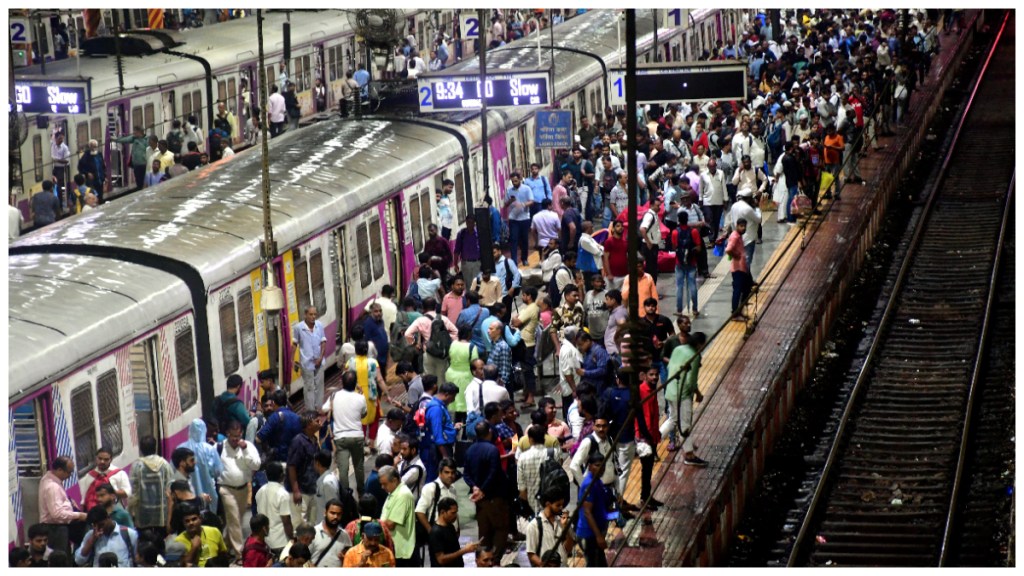Mumbai and various regions of Maharashtra were lashed by relentless rainfall, leading to significant traffic disruptions across the city. The intense rainfall led to severe waterlogging, affecting local train services and flight operations, while also triggering major traffic congestion. In light of the India Meteorological Department’s (IMD) red alert warning, authorities swiftly responded by closing schools and colleges in Mumbai, Pune, Thane, and Palghar for Thursday. As the city grapples with the aftermath of this deluge, the impact on daily life and travel remains profound, underscoring the challenges posed by the monsoon season in one of India’s most bustling metropolises.
Mumbai Train Services Affected
Many passengers were seen stranded at the CST Station in Mumbai on Wednesday as a lot of local trains were delayed. The CSMT-Pune Indrayani Express (train number 22105) has been rescheduled and is running behind schedule, according to the latest update. Similarly, the LTT-HW Superfast Express (train number 12171) has also been rescheduled and will experience delays. Additionally, the LTT-GKP Special Express (train number 05326) is among several other trains that have been rescheduled and will be running late.
The Central Railway on Wednesday announced that slow train services in both directions between Vidyavihar and Mulund stations experienced disruptions starting at 9:10 PM. In contrast, the Western Railway reported that, despite the heavy rains impacting the city, local trains within its Mumbai suburban network continue to operate on schedule. As heavy rains persist in Mumbai and its surrounding areas since Wednesday evening, numerous local trains faced delays on Wednesday. However, the good news is that the local train services have mostly resumed and are expected to be fully running slowly by the end of the day.
Mumbai Flight Disruptions
Airlines such as SpiceJet, IndiGo, and Vistara had announced via posts on platform X that several flights might be diverted due to weather conditions. SpiceJet stated that due to the adverse weather in Mumbai, all departures and arrivals, along with their subsequent flights, could be affected. Passengers were advised to check their flight status.
IndiGo also issued a travel advisory, noting that with the ongoing rain in Mumbai, flight schedules are experiencing disruptions due to weather and air traffic congestion. The airline requested passengers to keep a check on their flight status as well.
Mumbai vehicular movement comes to a halt, traffic affected
According to data from the BMC, over 250 mm of rain was recorded in various areas between 4 PM and 10 PM. The heavy downpour resulted in motorists and pedestrians navigating through ankle-deep water, with neighborhoods such as Bhandup, Mulund, Vikhroli, and Chembur severely inundated. In the western suburbs, the low-lying Andheri subway was closed to traffic due to water accumulation reaching nearly two and a half feet.
The Eastern Express Highway experienced significant traffic congestion due to the heavy rainfall. Mumbai Traffic Police issued warnings about waterlogging at the Andheri and Malad subways, as well as in Sakhar Panchayat and Hindmata. An orange alert has been issued for Mumbai, Thane, Raigad, Sindhudurg, Dhule, Nandurbar, and Pune districts. According to the IMD’s forecast for Mumbai, heavy to very heavy rainfall and thunderstorms with lightning and gusty winds are anticipated in isolated areas.
On Wednesday night, a rain-related incident occurred on the Mumbra bypass road, where a landslide blocked the route after the downpour. Fire Officer Swapnil Sarnobat reported that the department was notified of the situation around 9:30 PM, prompting rescue teams to rush to the scene to clear the rocks from the roadway.
Southbound vehicles were redirected via Gokhale Bridge. Additionally, due to water accumulation at Malad Subway, traffic has been halted and rerouted via Sainath Road. The police also reported slow vehicular movement at Sakhar Panchayat, where water levels are around 2 feet, and at Hindmata, where levels range from 1 to 2 feet.

